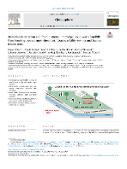| dc.contributor.author | Hiller, Edgar | |
| dc.contributor.author | Faragó, Tomáš | |
| dc.contributor.author | Kolesár, Martin | |
| dc.contributor.author | Filová, Lenka | |
| dc.contributor.author | Mihaljevič, Martin | |
| dc.contributor.author | Jurkovič, Ľubomír | |
| dc.contributor.author | Demko, Rastislav | |
| dc.contributor.author | Machlica, Andrej | |
| dc.contributor.author | Štefánek, Ján | |
| dc.contributor.author | Vítková, Martina | |
| dc.date.accessioned | 2024-12-05T14:40:55Z | |
| dc.date.available | 2024-12-05T14:40:55Z | |
| dc.date.issued | 2024 | |
| dc.identifier.uri | https://hdl.handle.net/20.500.14178/2741 | |
| dc.description.abstract | Landfills, especially those poorly managed, can negatively affect the environment and human beings through chemical contamination of soils and waters. This study investigates the soils of a historical municipal solid waste (MSW) landfill situated in the heart of a residential zone in the capital of Slovakia, Bratislava, with an emphasis on metal (loid) contamination and its consequences. Regardless of the depth, many of the soils exhibited high metal (loid) concentrations, mainly Cd, Cu, Pb, Sb, Sn and Zn (up to 24, 2620, 2420, 134, 811 and 6220 mg/kg, respectively), classifying them as extremely contaminated based on the geo-accumulation index (I(geo) >5). The stable lead isotopic ratios of the landfill topsoil varied widely (1.1679-1.2074 for (206)Pb/(207)Pb and 2.0573-2.1111 for (208)Pb/(206)Pb) and indicated that Pb contained a natural component and an anthropogenic component, likely municipal solid waste incineration (MSWI) ash and construction waste. Oral bioaccessibility of metal (loid)s in the topsoil was variable with Cd (73.2-106%) and Fe (0.98-2.10%) being the most and least bioaccessible, respectively. The variation of metal (loid) bioaccessibility among the soils could be explained by differences in their geochemical fractionation as shown by positive correlations of bioaccessibility values with the first two fractions of BCR (Community Bureau of Reference) sequential extraction for As, Cd, Mn, Ni, Pb, Sn and Zn. The results of geochemical fractionation coupled with the mineralogical characterisation of topsoil showed that the reservoir of bioaccessible metal (loid)s was calcite and Fe (hydr)oxides. Based on aqua regia metal (loid) concentrations, a non-carcinogenic risk was demonstrated for children (HI = 1.59) but no risk taking into account their bioaccessible concentrations (HI = 0.65). This study emphasises the need for detailed research of the geochemistry of wastes deposited in urban soils to assess the potentially hazardous sources and determine the actual bioaccessibility and human health risks of the accumulated metal (loid)s. | en |
| dc.language.iso | en | |
| dc.relation.url | https://doi.org/10.1016/j.chemosphere.2024.142677 | |
| dc.rights | Creative Commons Uveďte původ 4.0 International | cs |
| dc.rights | Creative Commons Attribution 4.0 International | en |
| dc.title | Metal(loid)s in urban soil from historical municipal solid waste landfill: Geochemistry, source apportionment, bioaccessibility testing and human health risks | en |
| dcterms.accessRights | openAccess | |
| dcterms.license | https://creativecommons.org/licenses/by/4.0/legalcode | |
| dc.date.updated | 2025-03-20T05:11:20Z | |
| dc.subject.keyword | bioaccessibility | en |
| dc.subject.keyword | contamination | en |
| dc.subject.keyword | health risks | en |
| dc.subject.keyword | landfill | en |
| dc.subject.keyword | soil | en |
| dc.subject.keyword | trace metals | en |
| dc.identifier.eissn | 1879-1298 | |
| dc.relation.fundingReference | info:eu-repo/grantAgreement/MSM//EH22_008/0004605 | |
| dc.relation.fundingReference | info:eu-repo/grantAgreement/UK/COOP/COOP | |
| dc.date.embargoStartDate | 2025-03-20 | |
| dc.type.obd | 73 | |
| dc.type.version | info:eu-repo/semantics/publishedVersion | |
| dc.identifier.doi | 10.1016/j.chemosphere.2024.142677 | |
| dc.identifier.eidScopus | 2-s2.0-85196716789 | |
| dc.identifier.obd | 654741 | |
| dc.identifier.pubmed | 38908448 | |
| dc.subject.rivPrimary | 10000::10500::10505 | |
| dcterms.isPartOf.name | Chemosphere | |
| dcterms.isPartOf.issn | 0045-6535 | |
| dcterms.isPartOf.journalYear | 2024 | |
| dcterms.isPartOf.journalVolume | 362 | |
| dcterms.isPartOf.journalIssue | August | |
| uk.faculty.primaryId | 115 | |
| uk.faculty.primaryName | Přírodovědecká fakulta | cs |
| uk.faculty.primaryName | Faculty of Science | en |
| uk.department.primaryId | 1063 | |
| uk.department.primaryName | Ústav geochemie, mineralogie a nerostných zdrojů | cs |
| uk.department.primaryName | Institute of Geochemistry, Mineralogy and Mineral Resources | en |
| dc.type.obdHierarchyCs | ČLÁNEK V ČASOPISU::článek v časopisu::původní článek | cs |
| dc.type.obdHierarchyEn | JOURNAL ARTICLE::journal article::original article | en |
| dc.type.obdHierarchyCode | 73::152::206 | en |
| uk.displayTitle | Metal(loid)s in urban soil from historical municipal solid waste landfill: Geochemistry, source apportionment, bioaccessibility testing and human health risks | en |

